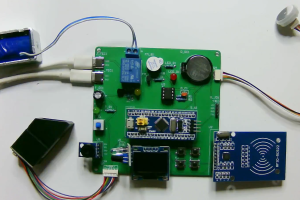设计说明书
总字数:18000+
随着社会智能化的普及,人们对小区居住环境的安全性、便捷性提出了更高要求,根据门禁系统的安全性和可靠性的基本需求,设计了一款基于STM32单片机的智能门禁系统。设计以STM32单片机为主控芯片,结合RFID刷卡模块、非接触测温模块、扫描枪模块、红外避障模块、OLED显示模块、存储模块、继电器模块、指纹识别模块、报警模块以及独立按键模块实现了门禁系统的智能化功能。通过测试,用户首先需要进行刷卡,扫码或者指纹其中一种方式进行确认,其次需要检测到人并且通过非接触测温检测当前体温在设置的范围之内进行开锁。经测试系统操作简单可靠,适合老人或小孩使用。此设计在门禁系统的安全性及可靠性方面具有一定的现实意义。
关键词:STM32单片机;RFID刷卡;OLED显示;非接触测温;指纹识别模块
With the popularization of social intelligence, people have put forward higher requirements for the security and convenience of the community living environment. According to the basic needs of security and reliability of the access control system, an intelligent access control system based on STM32 microcontroller is designed. The design uses STM32 microcontroller as the main control chip, combined with RFID swipe card module, non-contact temperature measurement module, scan gun module, infrared obstacle avoidance module, OLED display module, storage module, relay module, fingerprint recognition module, alarm module and independent button module to realize the intelligent functions of the access control system. Through the test, the user first needs to swipe the card, scan the code or fingerprint one of the ways to confirm, followed by the need to detect the person and through non-contact temperature measurement to detect the current body temperature within the set range to open the lock. The system has been tested to be simple and reliable, suitable for the elderly or children. This design has some practical significance in terms of security and reliability of the access control system.
Keywords: STM32 microcontroller; RFID swipe card; OLED display; contactless temperature measurement; fingerprint recognition
目 录
第1章 引 言
1.1 选题背景及实际意义
1.2 国内外发展历程
1.3 本论文研究目标
1.4本论文框架结构
1.5本文主要研究方法
1.6 本章小结
第2章 系统设计方案
2.1 主要元器件选择
2.1.1 主控芯片选择
2.1.2 避障模块方案选择
2.1.3 非接触温度模块方案选择
2.1.4显示模块方案选择
2.2 整体设计方案
2.3本章小结
第3章 系统硬件电路设计
3.1 主控电路模块
3.1.1 主控芯片介绍
3.1.2 单片机最小系统
3.2 RFID刷卡模块
3.3 非接触测温模块
3.4 红外避障模块
3.5 指纹模块
3.6 扫描枪模块
3.7 OLED显示模块
3.8 继电器模块
3.9 独立按键模块
3.10 AT24C02存储模块
3.11 声光报警模块
3.12本章小结
第4章 系统软件程序设计
4.1 编程软件简介
4.2 系统主程序设计
4.3 独立按键子程序设计
4.4 存储模块子程序设计
4.5 温度检测子程序设计
4.6 OLED显示子程序设计
4.7 本章小结
第五章 实物制作与调试
5.1 实物制作
5.2 整体模块测试
5.3 阈值设置模块测试
5.4 扫码枪模块测试
5.5 指纹模块测试
5.6 RFID刷卡模块测试
5.7 存储模块测试
5.8 本章小结
结 论
参考文献
致 谢
附录
附录一: 原理图
附录二:PCB
附录三:程序
购买后可查看具体内容!

